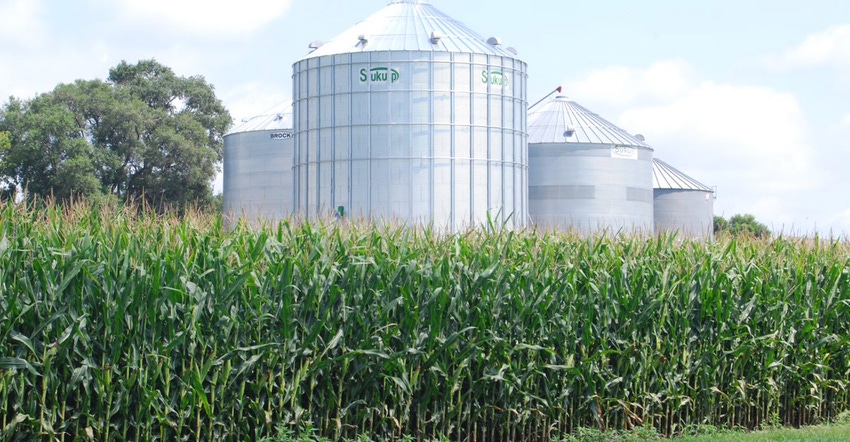July 30, 2019

With one of the wettest springs on record, timely harvest of this year’s crops could prove challenging. Start your preparation early, even though much of the Corn Belt harvest will be slightly later than normal. Producers will likely be filing a larger-than-normal number of crop insurance indemnity claims this year, which will require good records and communication with their crop insurance agent and USDA’s Farm Service Agency.
Yield variability, harvest losses
Expect greater in-field yield variability that could affect both quantity and quality of the grain harvested. Plan on making regular combine adjustments, as smaller ears and kernels will be more common.
There are two basic areas where harvest yield loss occurs: preharvest and during harvest. Loss of corn from lodging is represented by whole ear loss due to downed plants. Generally, these losses increase as the season progresses when plants dry and weaken. Under ideal conditions, these losses should account for less than 1% of total crop yield but can be much higher under adverse conditions or with delayed harvest.
Harvest losses can’t be eliminated. However, they can be reduced to 1 bushel per acre or less in good standing corn and soybeans if you take time to check performance of your combine. You’ll need to know where losses occur, how to measure them, what reasonable loss levels are, and what machine adjustments and operating practices will reduce the losses. Keep your combine properly maintained; check the operator’s manual for suggested settings to properly gather and clean the grain.
Yield monitor data
Try to keep production records for crop insurance purposes by field. This too could prove challenging with the number of acres that were planted late in addition to replant. Remember, production evidence for crop insurance losses can initially be “soft records” as required by the industry. These records are typically yield monitor data or scales on grain carts with proof of calibration.
Also, consider the need for crop insurance “hard records,” or those verified by a third party. Examples include crop insurance adjuster information, warehouse receipts, settlement sheets and certified grain bin measurements.
Drying and shrink
Cost of drying corn will often depend on moisture levels at harvest, which could be higher than normal. Many farmers prefer to dry corn on-farm to 13% to 13.5% moisture, especially if it’s to be stored beyond winter months. Corn harvested and delivered to an elevator or processor will be adjusted to 15% moisture. However, corn to be stored under warehouse receipt will be adjusted to 14% moisture.
Because corn is sold on a weight basis (No. 2 corn weighs 56 pounds), additional moisture for stored corn also reduces the number of bushels. To compute the extra shrinkage for farm-stored corn, use a shrink factor of 1.25%. Commercial elevators often use a shrink factor of 1.35% to 1.4%. The extra shrink cost is calculated by multiplying the extra points of moisture removed times the shrink factor times current corn price.
Storage, basis and futures spreads
If grain can be stored in existing on-farm storage facilities, ownership costs (depreciation, electricity, maintenance, insurance, etc.) could easily run 1 to 2 cents per bushel per month. Bushels stored commercially run 3 to 4 cents per bushel each month they’re stored. Commercial storage charges vary among elevators, but usually are a fixed charge for the first few months, with a slightly lower charge for each additional month thereafter.
If you plan on storing longer term, dry and cool the grain as quickly as possible following harvest to maintain grain quality and a longer shelf life for storage. Expect both corn and soybean ending stocks to decline come August 2020. As a result, regional basis (cash minus nearby futures) will be stronger. However, the futures spreads among the corn trading months will decline and could limit a positive return to storage.
Grain, interest and cash flow
The cost of moving grain in and out of farm storage varies by type of handling equipment, bin size and bin shape. Generally, handling costs are greater for flat storage and smaller bins. The extra handling costs associated with most farm storage facilities range from 2 to 2.5 cents per bushel and is accrued each time the grain is handled. With potential for greater quality concerns with this years’ harvest, consider limiting the quantity of bushels you commingle or blend off with old crop bushels.
Don’t forget there’s a time value of money. This will reflect as unpaid interest costs for having money tied up in stored grain inventory. If a farmer has a loan, it can be repaid with proceeds from sale of grain. So, interest expense is reduced if the grain is sold at harvest or soon afterward as basis strengthens. But if the grain is stored and the loan is not repaid, interest expense continues. Interest costs could run from 1 to 2 cents per bushel per month for corn and 3 to 5 cents per bushel per month for soybeans.
The string of six straight years of above trendline U.S. corn yields will likely be broken in 2019. The result will be higher cash prices and increased crop insurance indemnity claims that should benefit producers’ cash flows. However, we expect profit margins to remain tight for farmers who didn’t sell the spring futures price rallies or had poor yields not covered by crop insurance.
Take time before harvest to consider the need to improve drainage and to remedy soil compaction in your fields. Prevented planting acres especially can provide an opportunity to get that work done early. Also, consider booking propane, fuel, fall fertilizer and seed ahead. You can expect U.S. corn planted acres will increase for 2020.
Johnson is the ISU Extension farm management specialist in central Iowa. Contact him at [email protected].
About the Author(s)
You May Also Like






